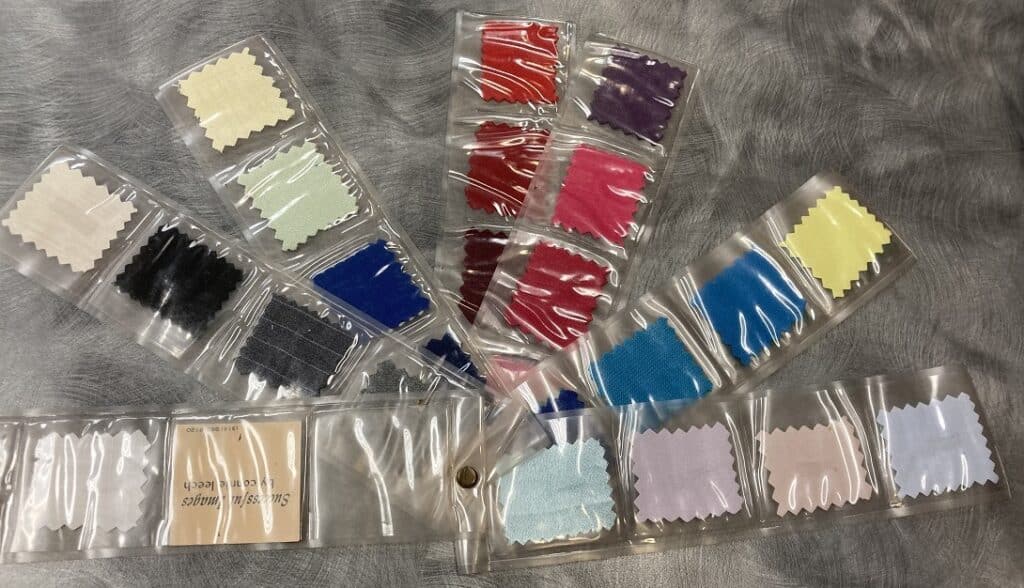Blog
Top Design Gains Professional Opportunity for Student
A round of applause is in order for Siba Interior Design student, Brittany Dirnberger! Thanks to her winning commercial design submission, Brittany won an all-expenses-paid trip to the IIDA SHIFT Conference in Dallas this year!!
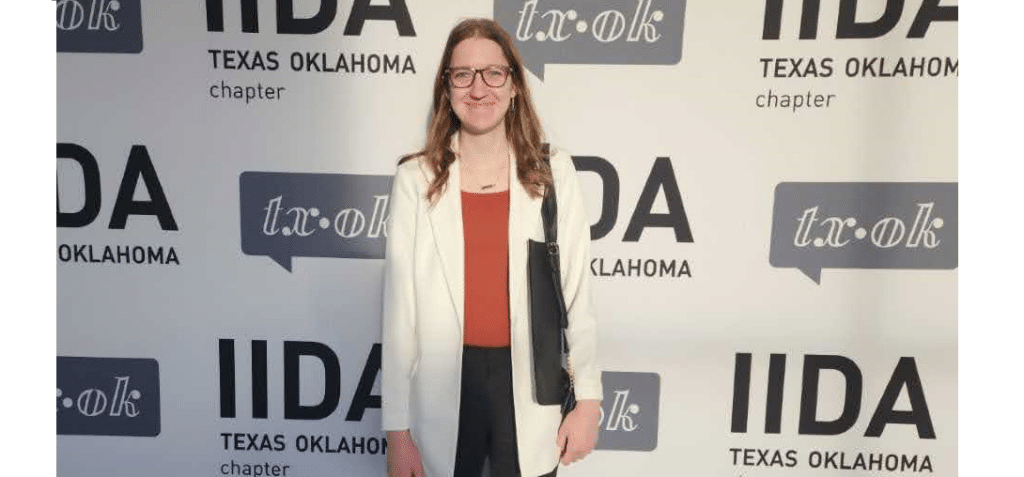
The annual SHIFT Conference, held in February and organized by the Oklahoma and Texas IIDA Chapters, provides a memorable, educational experience for the future of the design industry—uniting as one to guide students as they shift from their school careers to their professional careers. Of the event, Brittany says, “The conference lasts three days and is filled with events such as panel discussions, presentations, mock interviews, portfolio reviews, and networking events. As an attendee this year I was able to gain valuable knowledge and meet amazing interior design professionals from other parts of the country.”

In order to win her invitation to the conference, Brittany first submitted a commercial design concept, which was inspired by a project she’s working on at Siba for her Advanced Commercial Design class, to the local St. Louis IIDA Gateway chapter.
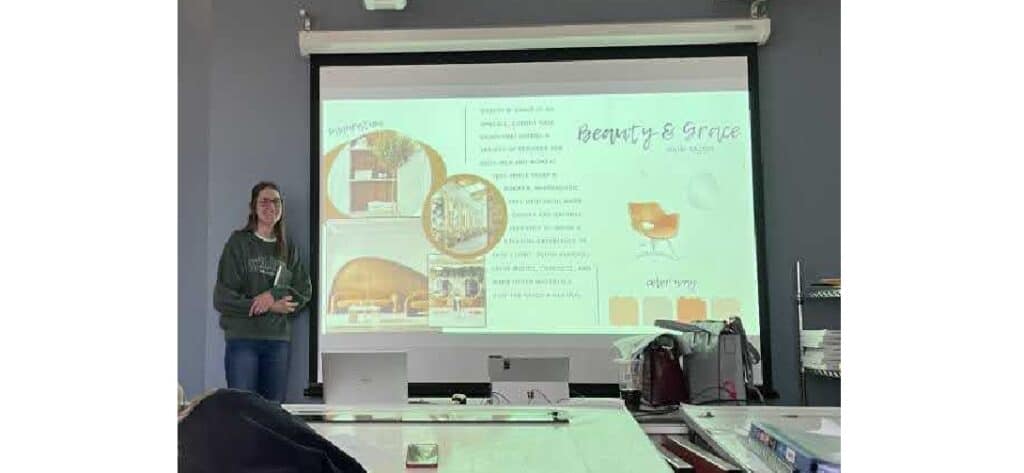
The plan so impressed judges that Brittany was one of just two students from our region to be awarded a complimentary trip to the IIDA SHIFT Conference. Although restaurant designs are always a popular project choice in the Advanced Commercial class, Brittany explained that she wanted to try a different kind of commercial space: "Rather than going with a restaurant layout, I opted to design a hair salon. The goal was to create a modern and elegant space with rich, bold colors."
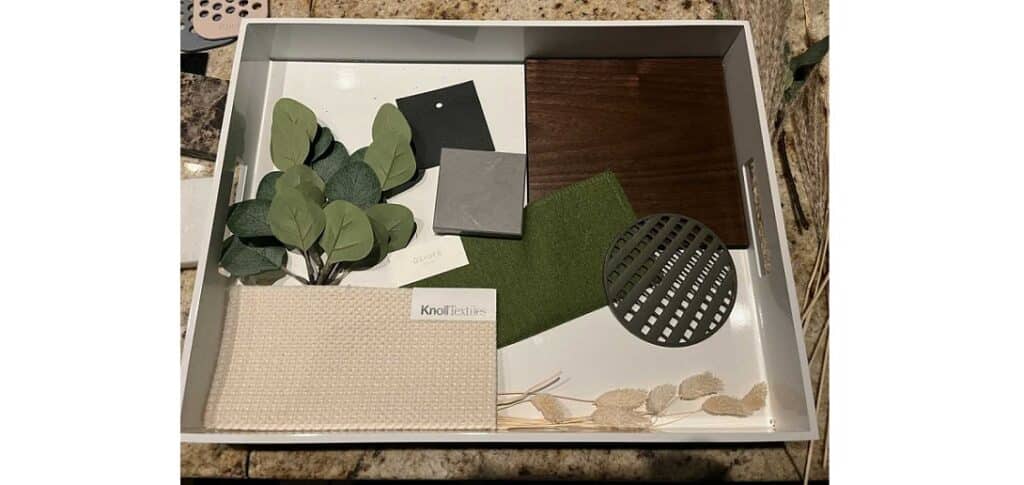
Reflecting on the experience, Brittany credits the role of her education at Siba in shaping her competition entry. "Several classes at Siba significantly contributed to my design. I was able to include a rendered lobby view in my presentation with the skills I’ve learn on Revit along with a floor plan that I drew in the AutoCAD program. My Textiles and Color Theory classes aided me in knowing what fabrics and colors to use together to complete my design.”
Winning the competition allowed Brittany to engage in a variety of events at SHIFT in Texas, including panel discussions, as well as networking sessions. All of which she found to be very educational. "The panels and talks that I attended were led by working designers who helped me to learn more about the current state of the industry as well as how to successfully transition from interior design student into interior design professional.”
Overall, the IIDA SHIFT Conference 2024 highlighted the transformative power of design education and fostering connections within the design community. "I am beyond thankful for this experience." Congratulations to Brittany on such a huge accomplishment! We are SO proud of you!
Why an Accelerated Degree is the Answer for Skeptics
Perhaps one of the biggest decisions you will make in life is whether you will pursue a college education, and if so, what will that education look like? For someone skeptical about the time it takes to earn a bachelor’s or even an associate degree, we think the answer might be an accelerated program such as the ones offered at Siba. Students on the accelerated path at Siba can earn their Associate of Applied Science (AAS) in as little as 18 months or their Bachelor’s degree in 36 months. Here are five compelling reasons we think an accelerated degree might just be the perfect fit for you.

Start Your Career Sooner!
Perhaps one of your main concerns is the time it takes to transition from the classroom to a professional career. Siba’s accelerated degree programs give our students the opportunity to condense the traditional college timeline. In fact, we at Siba pride ourselves on the many internship, externship, networking, and mentorship opportunities our degree programs offer well before graduation - strengthening your arrival into the professional world. This not only means an earlier entry into the workforce but also enables our students to start building their careers and making meaningful contributions to their communities, resumes, and portfolios sooner.
Cost-Efficiency
One of the biggest concerns we address with our prospective students is cost. While we proudly offer students who remain continuously enrolled the guarantee to lock in their tuition rate so that costs are known and controlled, our accelerated programs also put our students in the fast lane to capitalize on their earnings potential. On the accelerated path at Siba, you’ll have fewer years in school, and a head start to pursue a career (and paycheck) you love.
Intensive Learning and Focus
Siba’s accelerated degree programs are designed to immerse students in their fields. Our programs guide students on the subjects that matter the most when it comes to landing a job. There is no excess or “fluff”. With a concentrated curriculum, students delve deeply into their passion, honing their skills and mastering the subject matter. What’s more, Siba’s focus on hands-on learning ensures that these newly-learned principles resonate well beyond graduation.
Adaptability to Changing Industries
Between rapidly developing technology and a post-pandemic economy that continues to evolve, an accelerated degree from Siba is inherently adaptable, allowing students to stay ahead of industry changes. By completing your education in a shorter time frame, you are better positioned to embrace emerging technologies, trends, and opportunities. Our programs encourage you to be nimble, and
works continuously to update coursework to stay on pace with the skills employers demand.

VIP Treatment for All Students
Siba’s 9 to 1 student to instructor ratio translates to a more intimate and nurturing learning environment where students automatically receive individual guidance and feedback. Our supportive campus environment creates a sense of community and collaboration, allowing students to form valuable connections with both peers and faculty. We also understand that most of our students have responsibilities outside of school to consider, so we do our best to make your school schedule work with those other parts of your life. If you are on an accelerated path and you need to slow it down for a term or two in order to better manage your other commitments, we are here to help you craft the course schedule that works best for you each and every term.
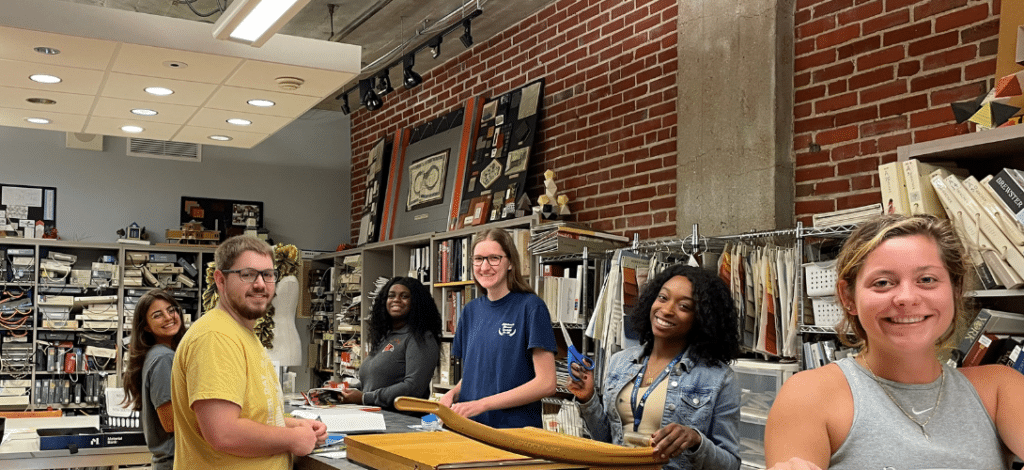
We think it’s pretty clear; an accelerated degree at Siba offers a multitude of benefits. Our 18-month Associate degree programs* and 36-month Bachelor’s degree programs* offer motivated students the opportunity to earn their degree at a faster pace so they can get on with their new careers!
From faster entry into the professional arena to cost-efficiency, intensive learning, adaptability, and personalized attention, the advantages of choosing an accelerated path are undeniable. If you’re hesitant about the traditional four-year route, an accelerated degree from Siba might just be the alternative solution you've been searching for.
*Students who have attended other colleges and universities who have earned qualifying transfer credits can earn their degrees in even less time than 18 or 36 months.
Spring Start at Siba

Spring isn't quite in the air, but Siba is enrolling now for our March start! Wherever you are in your college search - our Admissions representatives are ready to help you reach your educational goals. With programs in Business Administration, Fashion Development & Merchandising, Graphic Design, and Interior Design; Siba is where the art of business meets the business of art.
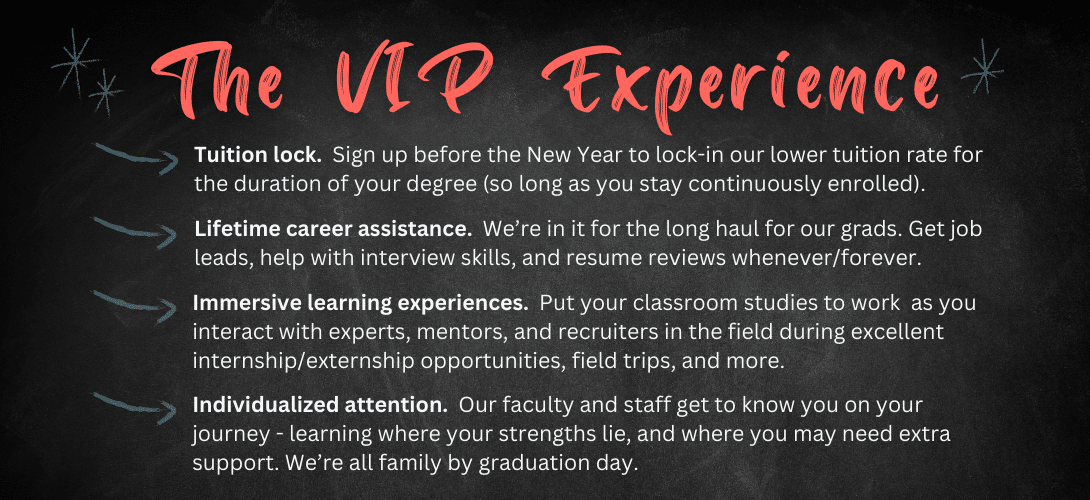
Don't miss out on this opportunity to learn in a supportive, hands-on environment in pursuit of a meaningful career. Call, text, or book your appointment online today and answer the call!
Start Something New at Siba – Backed by Science!
There’s nothing quite like the clean slate the New Year offers come January 1st. The challenges of the former year are behind us with the promise of new goals and accomplishments to be met head on. What better time to pursue the educational and professional dreams you’ve been thinking about for a while now? What better time to finish that degree you already started either at Siba or somewhere else? Siba offers the promise of a new start along with the support and motivation you need once the shine of the New Year begins to rub off.

Why now? There’s science to back up the pursuit of resolutions in the New Year. Researchers dub it the “fresh start effect.” Their findings suggest that landmark dates such as the New Year, generate a “mental accounting effect” where individuals can more effectively put the past behind them and look to the future with a renewed sense of drive.
Siba Fashion graduate Danielle Calcara got her fresh start at Siba, finding a new sense of purpose after working nearly a decade in cosmetology. After enrolling and excelling at an internship at local fashion industry leader, Stars Design Group, Danielle was later employed by Stars. From there, she founded her own consulting business, and Danielle’s initial decision to study at Siba is now paying dividends as she pursues her dream as fashion entrepreneur.
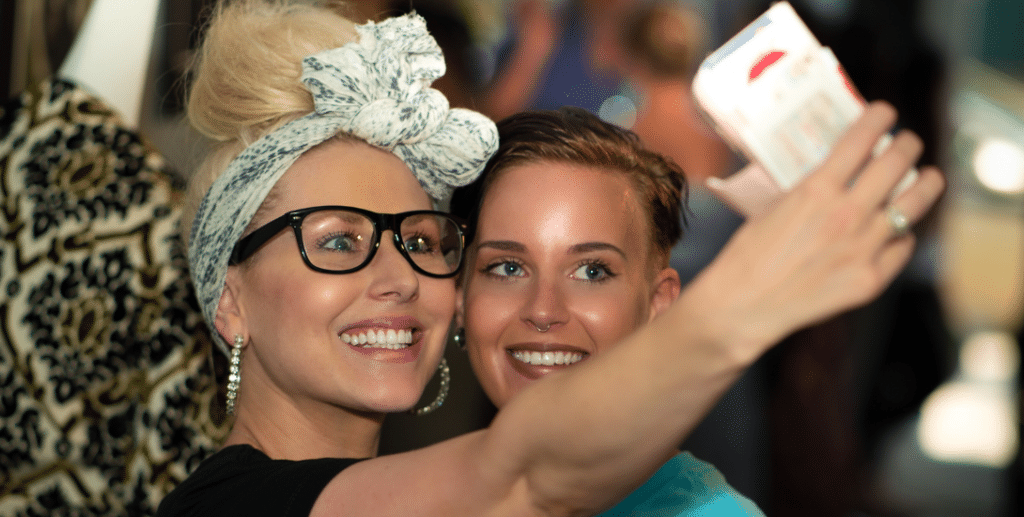
So what made Danielle successful when she started something new at Siba? Social scientist, Ayelet Fishbach, outlines her strategies to see New Year’s resolutions to the finish line in her interview with Scientific American. Central to her strategy are skills such as setting realistic goals and establishing a supportive environment - core values of Siba’s educational approach.
With AAS and Bachelor’s degrees in Business Administration, Fashion Development & Merchandising, Graphic Design, and Interior Design, Siba’s VIP approach works to set students up for success. Siba fosters an atmosphere where students are encouraged to set realistic milestones. Our attentive Department Heads and involved instructors act as mentors, providing the necessary accountability to keep those resolutions and goals on track.
In her interview with Scientific American, Fishbach also emphasizes the impact of social support on the success of resolutions. Siba proudly cultivates a tight-knit community where students not only learn from each other but also provide essential emotional and creative support. With small class sizes, Siba fosters both individual goal-setting as well as collaboration. Our campus located in downtown St. Louis was designed to further inspire these interactions.

Finally, Fishbach also touches on the effectiveness of positive reinforcement in maintaining resolutions. Siba proudly celebrates the achievements of our students (have you caught our latest billboard campaign?).
To sum it up, we think the New Year offers a perfect opportunity to embark on a degree program at Siba - backed by science. Come see how our nurturing faculty and staff can help support your dreams in January and beyond. Learn more about what makes us unique at siba.edu, check out our campus with a member of our friendly Admissions team, or send us your questions on our contact page. It’s a great time to start something new!
What it Means to be a Siba VIP
We are not exaggerating at Siba when we say that some very important people walk our hallways! Because we are small and specialized, we are able to treat all of our students and alumni as VIPs, and that is something that sets us apart from larger colleges and universities. And what better way to share that ideal with the community than to create a billboard campaign featuring Siba VIP Alumni from each of our programs? If you haven’t seen them already, they are currently being displayed on 25 digital billboards throughout the Bi-State region. The boards include both recent graduates who are already happily working in their fields and those who have been in the workforce building their careers for a few years.
VIP Jack Ryan Petee is a 2020 Business Administration graduate who impressed instructors from day one on campus and never stopped. Jack Ryan knew Siba was a good fit for him from the moment he took a tour of campus: “Within one minute of walking in the lobby and feeling the ‘vibe,’ I knew I wanted to attend.”
Siba offers both an Associates in Applied Science and a Bachelor of Science degree in Business Administration. Jack Ryan opted for his Bachelors and got the most out of one of Siba’s most versatile programs. Learning about finance, human resources, marketing, and entrepreneurship, Jack Ryan began his career in the world of finance upon graduation. He works now as a Wealth Management Specialist for a worldwide investment company and is among the VIP’s featured in our billboard campaign.

Another Siba VIP you might see on your drive is St. Louis fashion expert and entrepreneur AK Brown: The Fashion Connector. AK, a 2013 graduate of Siba’s Fashion program has worked extremely hard to build her brand in the St. Louis fashion scene and has achieved success after success. From blogger to editorial campaign director to non-profit leader, AK has carved out her own niche to become a veritable force in the fashion community - particularly for voices in the local Black Fashion community. In addition to all of her entrepreneurial and non-profit endeavors, AK is sharing the expertise she’s acquired over the past 10 years with new classes of VIPs as a full-time faculty member Siba’s Fashion Development & Merchandising programs!

So what exactly does it mean to be a Siba VIP? Let’s start with the one-on-one attention our students get. Within the first week or two of enrollment, all Siba students are known by their first names by every one of their instructors. Every student has ready access to their Department Head, Career Services Director, Academic Dean, Financial Aid Director and President. Within a few months, our Department Heads start identifying opportunities unique to their students’ strengths, while investing time and effort in assisting in areas where they may need more help.

Our students’ individual learning styles, career goals and challenges are met with understanding and consideration. Opportunities that will allow students to establish valuable contacts in their field of study include: participation in professional organizations, mentorships with community leaders and working professionals, field trips to studios and showrooms, and internships which can (and often do!) lead to full-time job offers once they graduate.
Being a Siba VIP means we acknowledge and value the investment you’re making in your education. Your tuition rate is locked in when you start your program and will never increase as long as you remain continuously enrolled. There are no complex fee schedules or need to invest thousands of dollars in textbooks. Instead, all of your textbooks and campus resources are covered by a single $250 fee charged each term.
Additionally, our student VIPs complete their degree at a pace that makes sense for them. Siba’s accelerated option makes the most sense for some - completing a Bachelor’s degree in 3 years (or less if you have any transfer credits), or an AAS degree in 18 months (or less) allows students to earn their degrees and get started in their new careers sooner rather than later. For other students who have more outside obligations to juggle, our part-time and evening schedules (for some programs) allow them to work and/or meet family needs while still pursuing their dream of earning a degree.
Amani Miller is a great example of a VIP who had many “balls in the air,” as they say. While enrolled in Siba’s Interior Design program, Amani was able to earn her degree while still focusing on her family and a job. She even found time to take a leadership role in the Siba student chapter of the American Society of Interior Designers Missouri East, which significantly enriched and expanded her education beyond the classroom. Because we wanted to do everything we could to facilitate ALL of her goals, Siba faculty and staff were there to customize Amani’s class schedules accordingly.

Siba’s dedication to the VIP treatment extends well beyond commencement. All of our graduates enjoy lifetime career assistance, whether it’s coaching with the application/interviewing process, making connections between employers and graduates, or helping fine-tune a resume and/or portfolio. We also welcome and encourage our alumni to come share their experience and insights with current students whenever they are able!
So while we hope you see our billboard campaign, we would love for you to visit our campus and experience the Siba VIP treatment for yourself. Our admissions team looks forward to giving you their undivided attention and answering all of your individual questions. Learn more at siba.edu, or make an appointment to take a tour of our campus on our scheduling site. We’re enrolling now for 2024!
Interior Design Trends at NeoCon
Among the benefits of an Interior Design degree at Siba is an opportunity every year to join students, alumni, and instructors on a trip to NeoCon – the premierMidwestern Interior Design tradeshow featuring far more than just industry developments. Participants interact with vendors, get introduced to the latest top-of-the-line materials and cutting-edge technology, and network with peers and potential employers.
We talked to Siba Department Head, Janelle Schrumpf, and some Siba interior design students to get their feedback on this year’s event. Here are some of their observations:
Integrated Technology is Everywhere!
Demand for high-tech integrated design in both residential and commercial spaces continues to grow in the industry. One of the Neocon highlights for Siba students this year was an off-site visit to DIRRT, a global leader in industrialized construction for interior spaces, where they were treated to a presentation of brand-new technology using VR (Virtual Reality). DIRRT specializes in adaptable, innovative design using VR and augmented reality space planning that allows clients to explore multiple options with the ability to visualize how each one aligns with their design preferences and functional requirements.
Technology is used seamlessly not just in presentation techniques, but in DIRRT designs as well. It’s frequently integrated in the build itself; think smart sensors, lighting that automatically adjusts when someone enters a room, and climate controls that prioritize energy efficiency, comfort, and convenience.
Schrumpf emphasized to her students the importance of understanding these innovations in their client consults, “Designers today need to be able to offer a number of technological solutions for the home, office, healthcare, and hospitality settings. Consumers may not even be aware of the full breadth of integrations available, so visits like this are critical for student designers to stay competitive in the industry.”
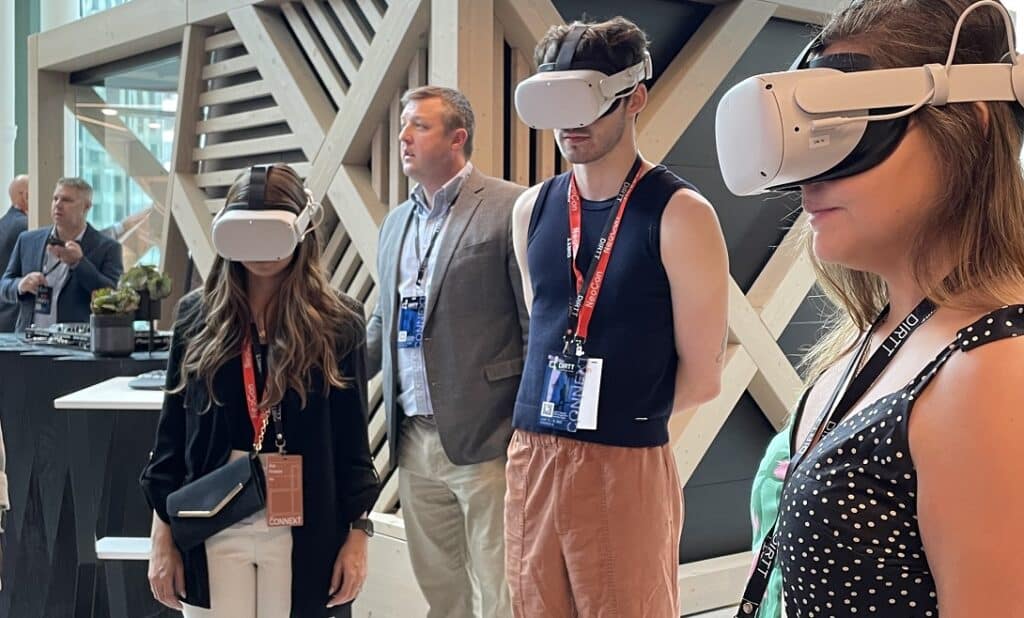
Trending Color: Shades of Terracotta
Strolling through Merchandise Mart where NeoCon is hosted each year, students couldn’t ignore the ubiquitous use of a very trendy color: terracotta. According to Schrumpf, this rich, earthy, reddish-brown hue evokes a sense of timelessness and authenticity, while also being a very current choice for contemporary designs seeking to embrace natural elements. The color’s versatility allows it to effortlessly complement a wide range of interior styles, from rustic and bohemian to modern and minimalist.
Students also noticed that vibrant colors are replacing the “millennial grays” and neutral palettes that dominated the last decade. Second-year student Brittany Dirnberger observed, “Color is making its way back in and we are starting to see bright, fun shades instead of all neutrals.”
Top Material: Metal
Schrumpf notes that metal is also having a moment. Vendors and designers are using a variety of elements including copper, brass, gold, silver, and iron. Whether it's through statement light fixtures, furniture, or intricate decorative elements, metals provide interesting texture and contrast. And their versatility allows them to be effortlessly incorporated into a variety of design styles. Students at NeoCon noted the way the use of metals contrasted with other materials such as wood, marble, and other natural elements – which brings us to another trend: “biophilic” design, a concept used within the building industry to increase occupant connectivity to the natural environment
Plant Popularity
Greenery-infused living walls are increasingly in demand – particularly in office designs. According to Schrumpf, “Biophilic design continues to be a popular way for architects and designers to create harmonious environments that foster well-being for their occupants.” NeoCon attendees saw it used in lush indoor gardens, as well as strategically placed potted plants and hanging vines. Their aesthetic appeal aside, plants offer numerous health benefits, purifying the air and reducing stress levels. With employers looking to make workspaces more enjoyable and environmentally-stimulating in this post-Covid era, plants showcase a celebration of nature and an appreciation for sustainable, mindful living.
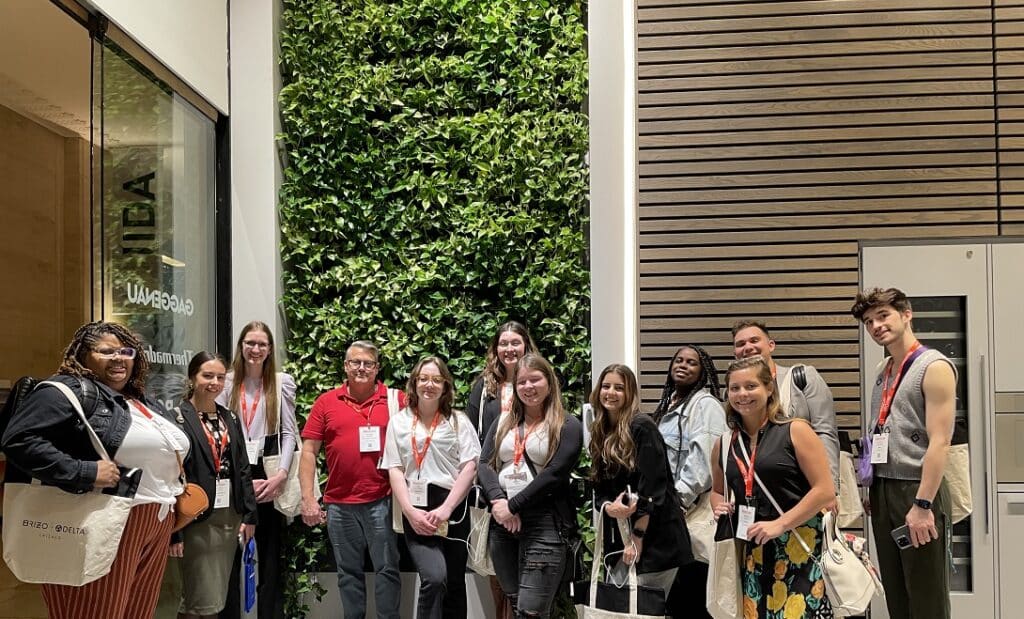
Craftsmanship is King
Central this year to NeoCon, as well as to this latest generation of designers, are responsibly sourced products and high-end craftsmanship. Students visited Haworth Design Lab, where they watched as members of the collaborative created custom furniture pieces. The Design Lab kicked off at Art Basel 2022 with a collection of artists that bring new ideas, design diversity and desirability through partnerships to advance the industry. Students watched as these artisans used woven materials and tufted chairs in live, interactive exhibits. Schrumpf says this trend speaks to clients of all backgrounds, “Consumers are demanding that manufacturers responsibly source their materials. This isn’t just a trend—it’s a public awareness that isn’t going away anytime soon. People want their goods to be ethically, thoughtfully, sustainably and artistically made.”
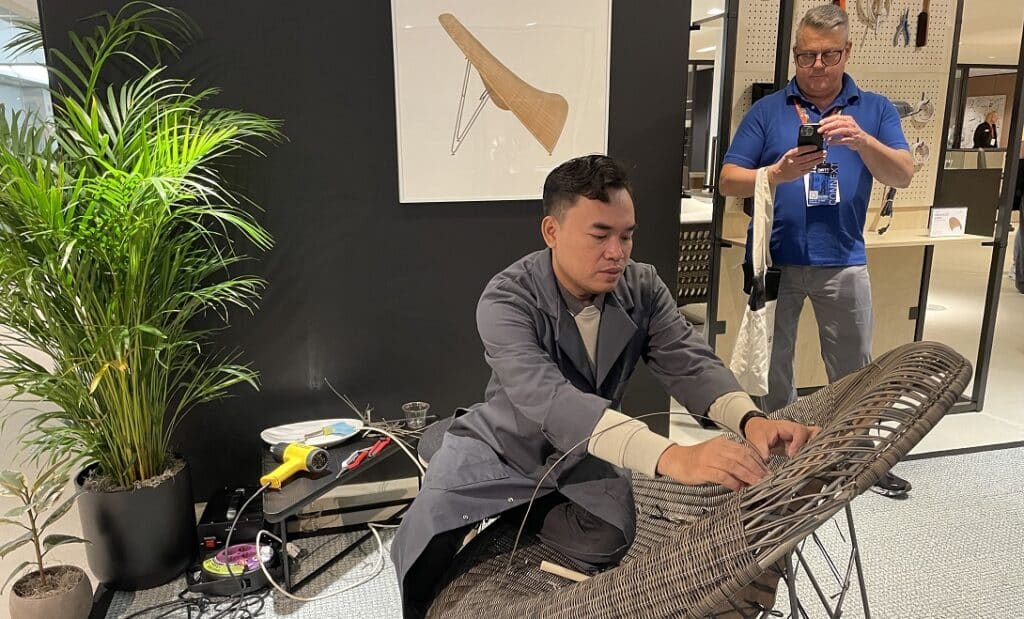
Curves and Circles Dominate
Curves are having their moment. According to student attendee Ella Mendenhall, “There are so many trends that I saw repeated throughout different showrooms. There were lots of curved lines and rounded edges, whether that was in furniture, lighting, or casework.” Schrumpf credits this trend with creating a sense of softness and visual flow within spaces. In office showrooms, it created a sense of inclusivity, particularly in meeting and co-working spaces.
Students also saw this trend during a visit to Knoll – a highlight of their trip to Chicago. Knoll, an icon among modern furniture designers, has played an historic role in the use of curves with the Saarinen Tulip Collection. This collection, introduced in the 1950’s, features dining tables, side tables, and chairs with graceful, sculptural curves that eliminate the need for four legs, creating an elegant and visually light appearance. The use of curves continues today in Knoll's modern designs, which students were able to soak in during their trip.
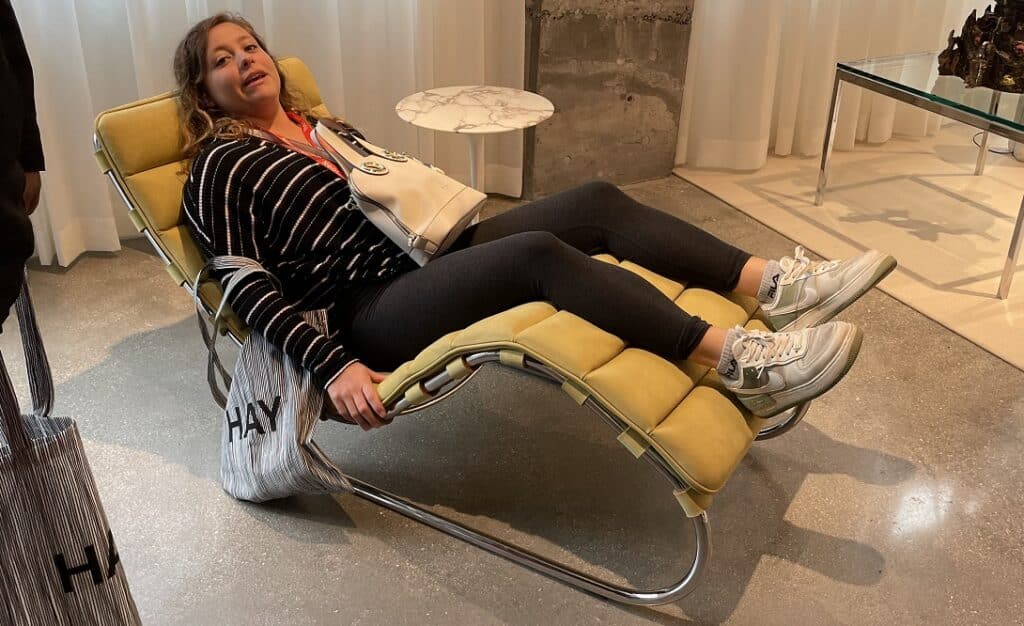
While the annual trip to NeoCon is popular among students in Siba’s Interior Design program for all its many sources of inspiration, students are able to make valuable connections with their peers and industry professionals. Mendenhall summarizes it this way, “This trip made me excited for my future in this field and it made me feel a sense of belonging. It was the moment I realized I was right where I was supposed to be and that I was on my way to becoming a designer. It was truly a special trip.”
We’re so happy students were able to see so much during their visit this year, and for the relationships they were able to develop!
Love and Coloring Books: Life after Graduation from Siba
A lot has happened in the five years since Graphic Design alumna Ellyn Cox-Hoff completed her Bachelor’s degree at Siba! Professional opportunities, personal milestones, a worldwide pandemic, and publishing a coloring book are just some of the things that have impacted Ellyn’s life since her commencement in 2018. We recently had a chance to catch up with her and get more details about these big events, and for all of the romantics out there, this particular “Graduate Spotlight” starts with a love story that began at Siba….
Siba: We heard that you married a fellow Siba student, which (due to our small size) is not a common occurrence. Congratulations!
Ellyn: Aaron Hoff (also an alum of the Graphic Design program) and I went on our first date about a month after I graduated. We’d formed an excellent friendship as classmates, hung out a lot, and I graduated first, but just by a few months. I found out later that he had decided to wait to ask me out until after I graduated in case I turned him down! I guess that could have been pretty awkward due to how small our campus and classes were. We had spent so much time together at school that when he asked me to dinner I didn’t even realize it was a date until the check came and he nervously paid for it. I asked if it was a date…and he asked if I wanted it to be. I did.
We got engaged in October of 2020 and didn’t wait for the pandemic to be over to have our wedding. We bought a house that November and married in December with a small ceremony on his great-great-great grandparents’ farm. In January we got a dog named Stan that we adore!
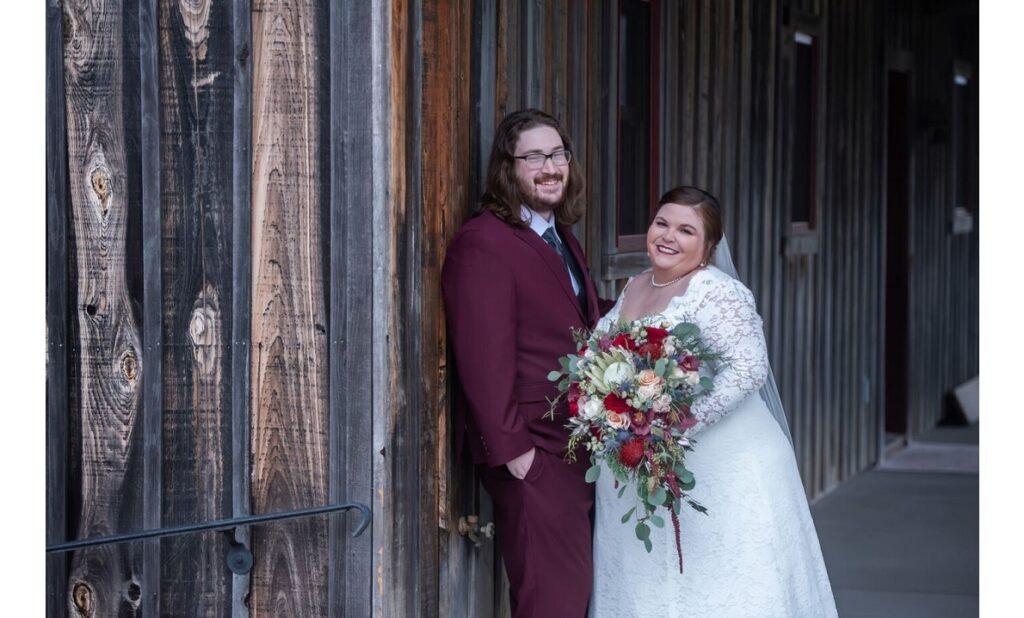
Siba: Switching to your professional accomplishments, we know that right after graduation you did some work for the Surge – St. Louis’ professional women’s basketball team. What were some big takeaways from your time there?
Ellyn: Working for the Surge was a fantastic experience. Observing a woman in leadership like Surge owner, Khalia Collier, was quite inspiring. I learned so much about the details of event-planning, from creative to logistics. It was such a wonderful opportunity for me to attend a number of professional events and creative meetings with various agencies and other organizations.
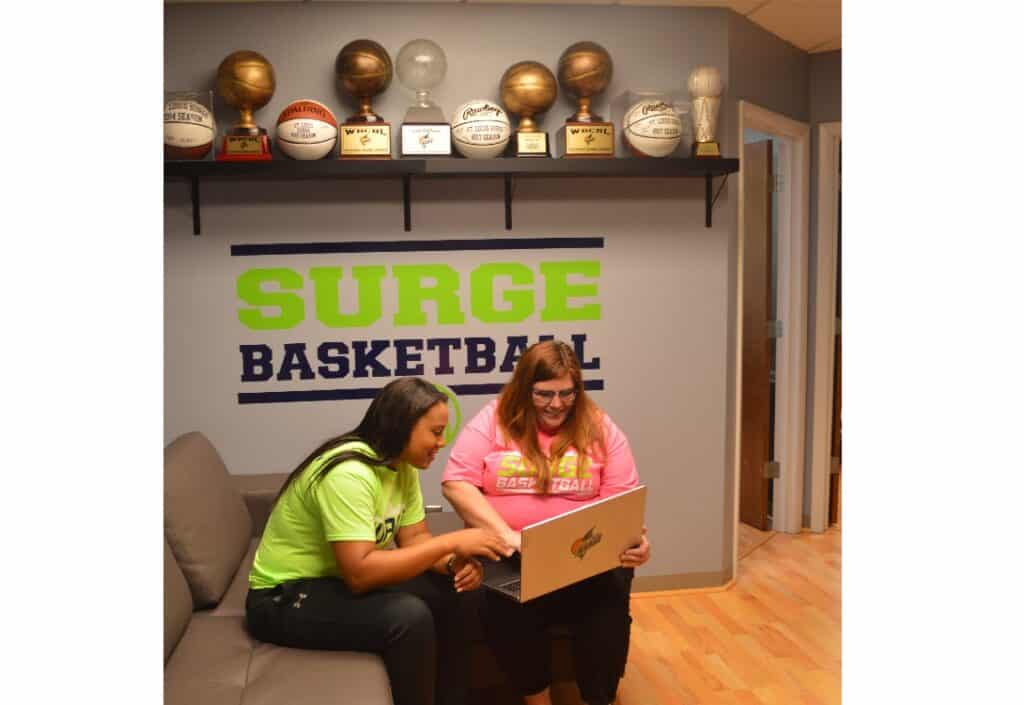
Siba: Where did you go after your time with the Surge?
Ellyn: About a year after graduation I started working at STL Shirt Co as a Graphic Designer. I worked there for almost 5 years and was promoted to “Lead Graphic Designer.” I’ve since moved on and am on the lookout for new opportunities. Aaron is working as a Graphic Designer at Soccer Master in Manchester, MO.
Siba: How would you describe your professional path since leaving Siba?
Ellyn: Networking is essential as you are struggling to find the right job. I also think it’s so important to stay connected with your classmates. My continued relationship with other Siba Graphic Design graduates has been so beneficial.

Siba: What were your favorite or most impactful classes at Siba?
Ellyn: The courses I appreciated the most were the Portfolio classes where we presented our work to local industry leaders and heard candid feedback from panels of professionals in addition to our instructors. Those honest critiques were invaluable.
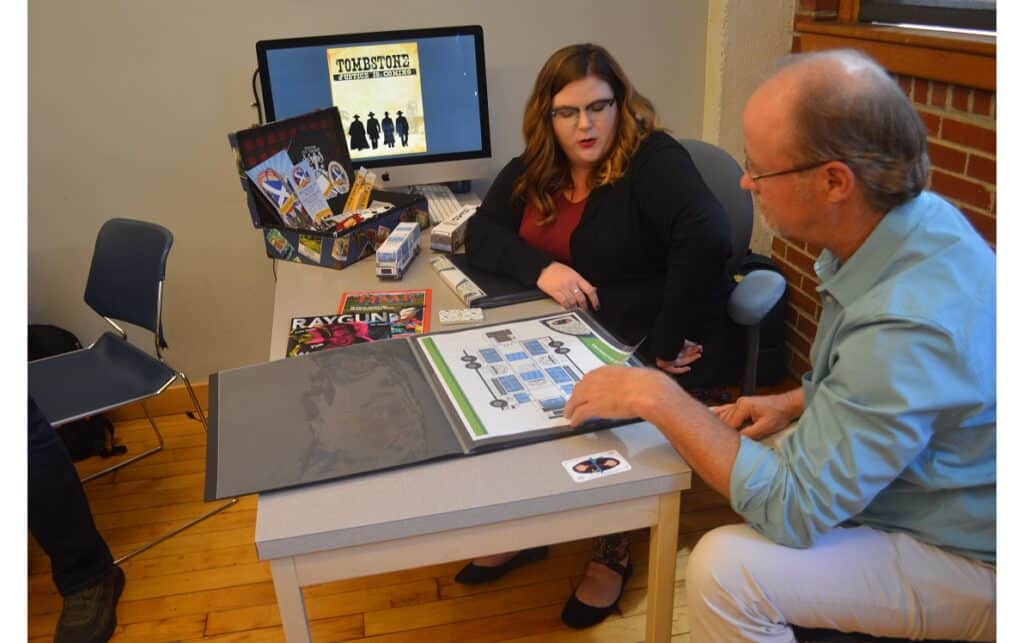
Siba: Your peers and instructors know you to have a strong work ethic and creative drive. What other attributes do you think are helpful in the industry?
Ellyn: You have to be determined and willing to compete for a job you love and can be proud of. It takes work but it’s worth it!
Siba: What advice would you offer to current Siba Graphic Design students who are getting ready to graduate?
Ellyn: Fine-tune your portfolio and put yourself out there in the graphic design community. I reached out to contacts I made by attending various events, and continued networking. I asked for feedback and tours of agencies. Those interactions helped me build confidence and make connections—you need to find ways to make yourself stand out and be memorable.
Siba: Any other accomplishments you would like to share?
Ellyn: During the pandemic I was laid off for a short time and I did a lot of puzzles and coloring, but soon ran out of materials that were inspiring, so I created my own coloring book entitled Inspiring Quotes by Powerful Women and had it published through Amazon. You can buy it here.

Siba: What brings you joy at the end of the day?
Ellyn: I honestly love my job. I don’t dread Mondays but I do love to come home to my little house that I get to share with my best friend and best dog.

Siba: Sounds like the perfect work/life balance to us. We wish Ellyn, Aaron, and Stan all the best and we can’t wait to see what the next chapter holds for this dynamic Graphic Design duo!
Enrolling for Fall!
Answer the call for Fall! Siba is enrolling for the Fall season with two starts so that you don't miss out on an opportunity to change your life. Wherever you are in your college search - our Admissions representatives are ready to help you reach your educational goals. With programs in Business Administration, Fashion Development & Merchandising, Graphic Design, and Interior Design; Siba is where the art of business meets the business of art.
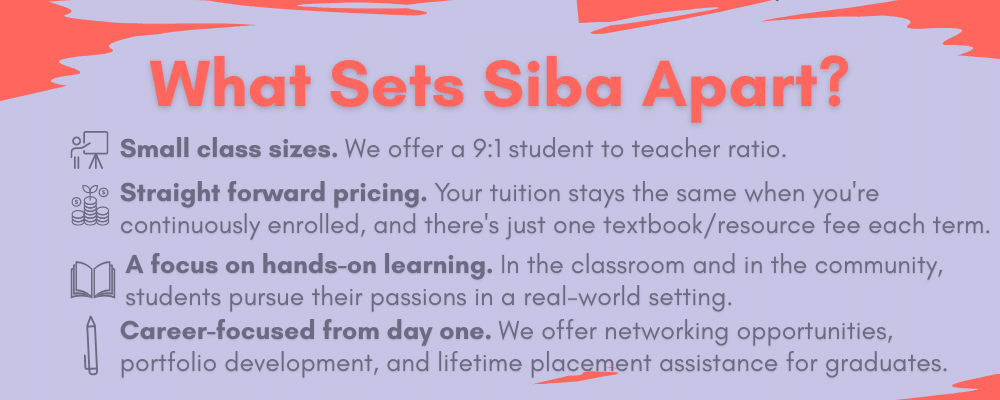
Don't miss out on this opportunity to learn in a supportive, hands-on environment in pursuit of a meaningful career. Call, text, or book your appointment online today and answer the call!
Students Explore the role of color in fashion and beauty.
Color is complicated and fascinating. It’s a huge factor in fashion design, product development, merchandising, and marketing. If you are of a certain age, you may remember Carole Jackson’s “Color Me Beautiful,” a system developed in the 1980’s that helped consumers find a color palette that best suited their unique combination of skin tone (warm or cool) eye color and hair color. Using those factors, clients were assigned a color palette that represented one of the four seasons (Spring, Summer, Winter and Fall) as a guide for what colors they should wear to optimize and complement their natural coloring.
Several updated more detailed color analysis systems have become wildly popular on sites like TikTok and YouTube. Developing the skill to do color analysis is important to fashion students pursuing careers in design, styling, product development, merchandising and retail.
Siba Fashion Development & Merchandising students recently participated in a color analysis exercise presented by guest speaker Alice Sydow of “Style Your Glow.” Sydow is a certified Color Analyst, Stylist, and image consultant.
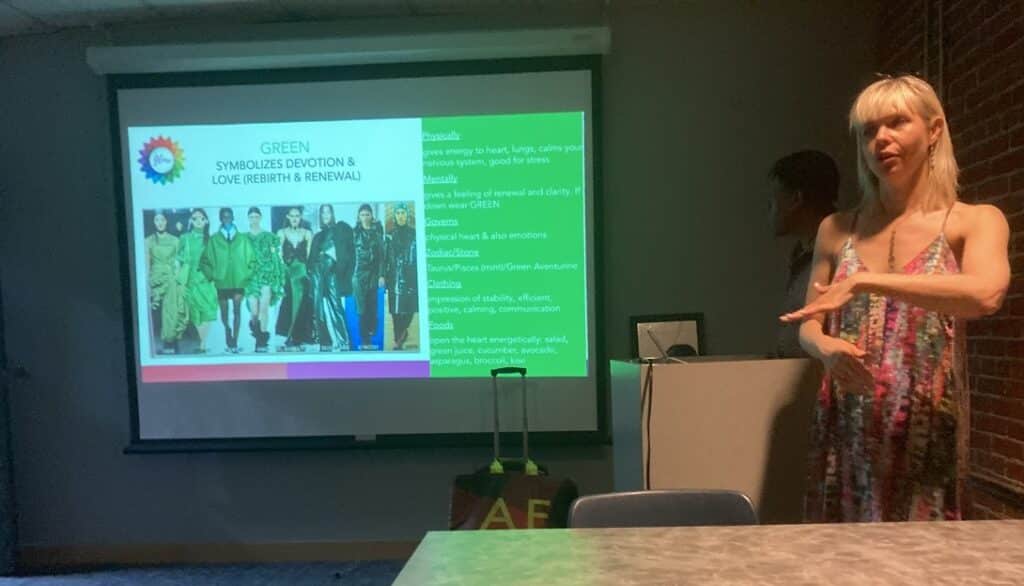
Sydow instantly connected with Siba students and what followed was an extremely informative, fun session on the most current and detailed color analysis method. The demonstration started with a brief explanation about color science and color psychology, and then one lucky fashion student volunteered for a personalized color analysis performed by Sydow, with input from the rest of the class.
Sydow’s analysis uses a 12 tonal system that provides more of a spectrum than the 1980’s four seasons approach. For example, one might be a Light Summer, True Summer, or Bright Summer rather than a just a Summer of the original Color Me Beautiful 4 tonal system. An example of the 12 tonal system pictured below.
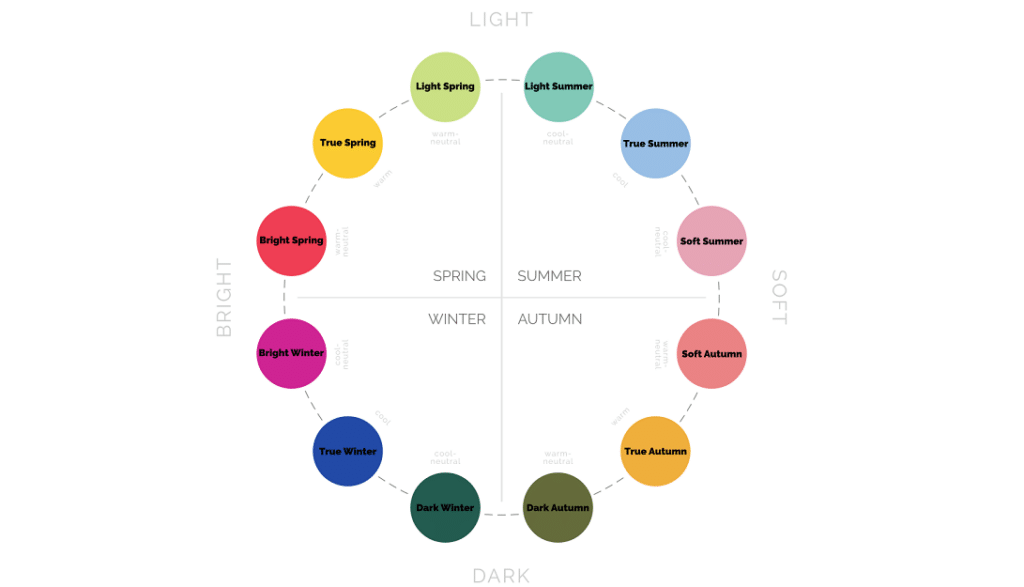
A simple starting point for color analysis is to determine whether the skin tone is warm or cool by comparing white and off-white fabric around the face, and then doing the same with gold and silver fabric. Chances are, if gold and off-white look better on you, you are warm. If white and silver look better, you are cool. Sydow and the other students agreed that our volunteer’s skin tone was cool. Below are various color palettes in the 12 tonal system that were each draped around the volunteer’s face.
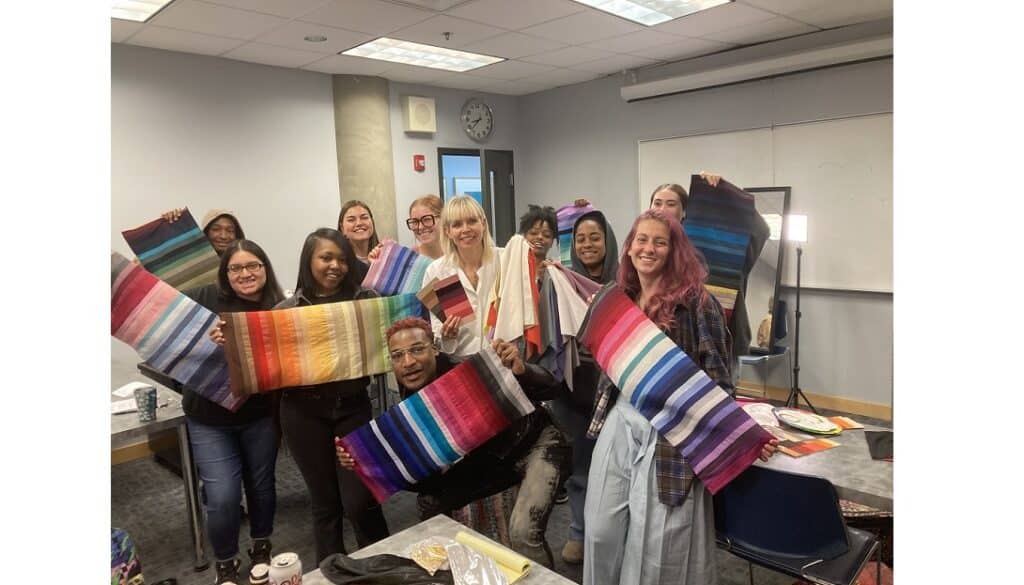
The students immediately noticed dramatic differences in the volunteer’s skin, hair, and eyes, depending upon the color palette placed around her face. Below is a photo of a palette that was not the volunteer’s best, because the colors are too strong and deep for her coloring.
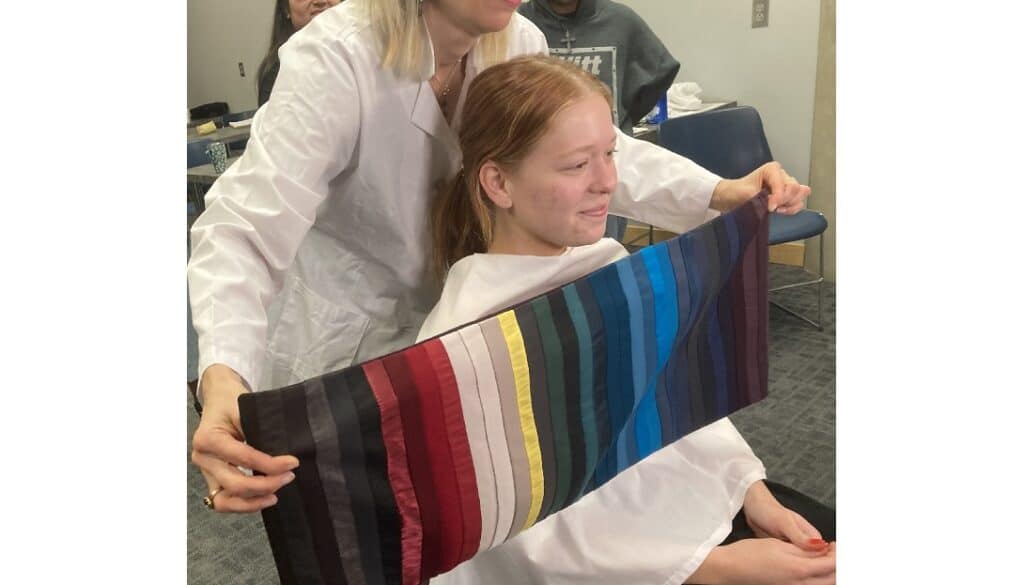
A much more flattering color palette is pictured below. All agreed that “Soft Summer” brought out the volunteer’s complexion, eye, lip, and hair color the best. She seemed to sparkle!
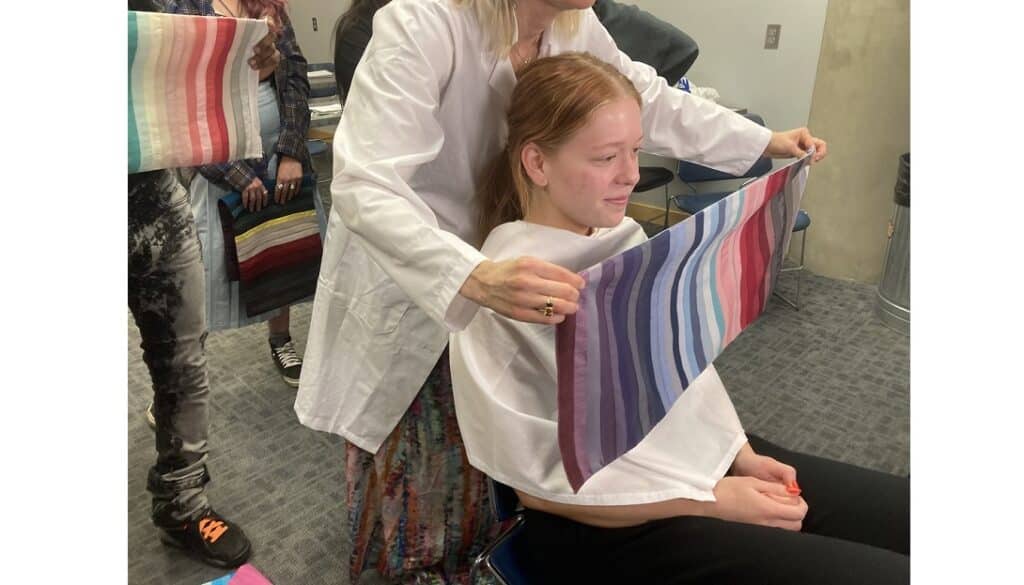
Students learned a valuable new skill from the relatable, knowledgeable, engaging Ms. Sydow and had a blast in the process! If you are interested in more information, check out Alice Sydow at @styleyourglow369 on Instagram and styleyourglow369 on TikTok.
Business Student Association Hosts Speaker
The Siba Business Students Association is pleased to welcome Ashley Timmons, Regional Manager at Drury Hotels, in their speaker series. Ms. Timmons will discuss career paths in her presentation Wednesday, May 17th from 5:30pm-6:30pm. All students are welcome!

The Best Places to Find Inspiration for your Home
Need Inspiration for your Interior Design Project? Siba’s Interior Design Department Chair Shares Her Favorite Resources:
Deciding that your space isn’t meeting your aesthetic expectations and/or functioning the way it should is the first step, but where are the best places to get ideas for the redo? Siba Interior Design Department Chair, Janelle Schrumpf, shares the sources she uses to find inspiration for her clients and students in the St. Louis Metro area.
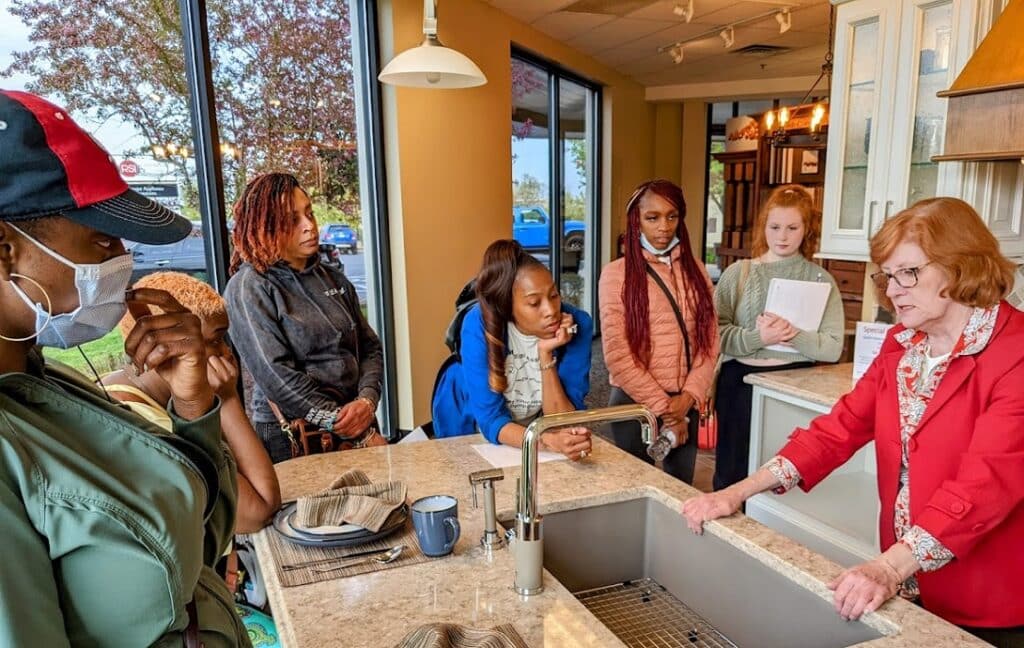
Interior Design Magazines
Both online and old-fashioned print versions of design and décor magazines top Schrumpf’s list of inspirational resources. Some of her favorites include local publications like St. Louis Homes Magazine. The magazine’s publisher and owner, Suzie Osterloh, has also been a great contact for Interior Design students in St. Louis looking to network and learn more about their new profession. Because they are published regularly, magazines are a great source of the most current and emerging trends in technology, color palettes, materials, finishes, floorplans, furnishings, organizational systems, etc. Schrumpf also recommends checking out Architectural Digest, Interior Design Magazine, The Business of Homes, Environments for Aging, Veranda, Elle Décor, and House Beautiful for examples of stunning homes, expert advice, and beautiful photography.
Museum Exhibits
It might be unexpected, but local museums and tourist attractions can be a great source of inspiration. Schrumpf points to the Global Threads—The Art & Fashion of Indian Chintz Exhibit and Art in Bloom event at the St. Louis Art Museum as two recent examples. Schrumpf also takes her students on field trips to the Frank Lloyd Wright museum in Ebsworth Park in Kirkwood, and to the Campbell House in downtown St. Louis for historic examples of design that still resonate today. We love a field trip at Siba!
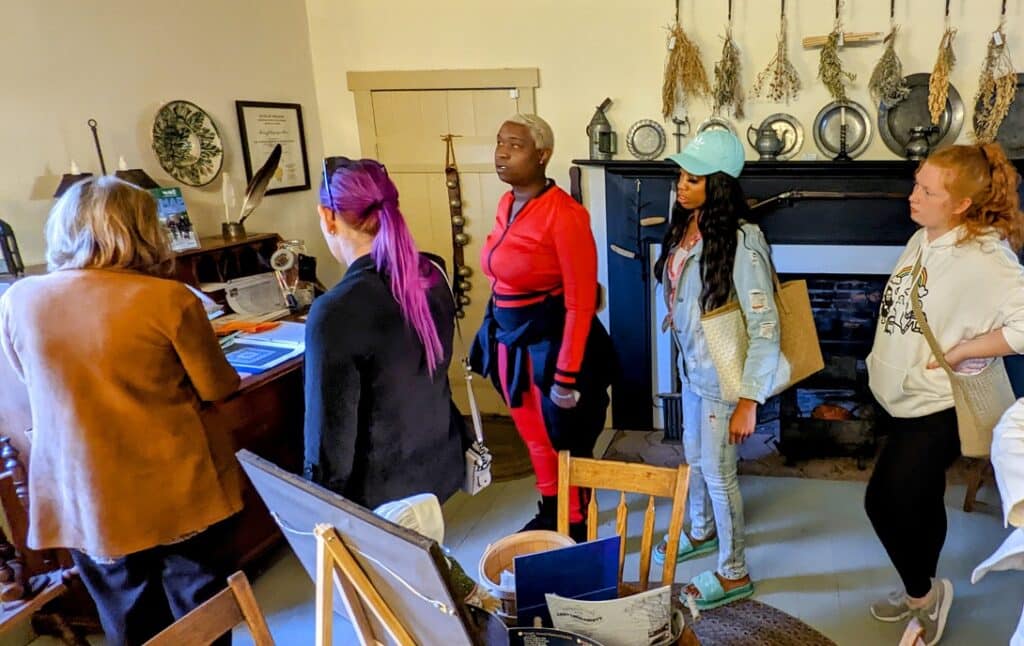
Social Media & Blogs
Social media sites like Pinterest, Instagram and YouTube offer an almost infinite supply of images and videos related to interior design. With search functions that make finding categories of interest (both broad and very specific) easily accessible, Siba students frequently get their inspirations for mood boards and new projects by using these platforms to jumpstart their creativity.
Additionally, home décor Blogs offer both insightful articles and personalized experiences in design. Our Interior Design department loves sites like Apartment Therapy and Cassandra Lavalle.
Brick & Mortar Shops and Stores
Schrumpf recommends that her clients visit retail stores and showrooms in their community to fine-tune their personal style and get an idea for the look and feel of the results they are seeking in a newly designed (or redesigned) room/space. Stores like West Elm, Crate & Barrel and Pottery Barn, home décor specialty shops like Cool Stuff and Urban Matter, resale and consignment shops like Green Goose, or even big box stores like Lowe’s and Home Depot can be a source of inspiration.
During their studies, Siba students frequently go on field trips to showrooms like KDR in St. Louis, which offers both retail services to the public and wholesale services to professional designers.
Online/Web-Based Home Furnishing Retailers
For clients who like to look for ideas on the web, Schrumpf recommends online home furnishing and décor retailers such as Houzz and Wayfair. These sites offer thousands of products in a wide range of prices, which can be very useful when trying to make smart design choices that fit the budget.
Nature and Outdoor Spaces
With recent trends borrowing inspiration from nature and green spaces, another place to find your design muse is outside. Schrumpf suggests taking a walk through your favorite park, a nature reserve like the August A. Busch Memorial Conservation Area or St. Louis treasure, the Missouri Botanical Garden, and consider the colors and textures you’re drawn to for a color schemes and/or material choices.
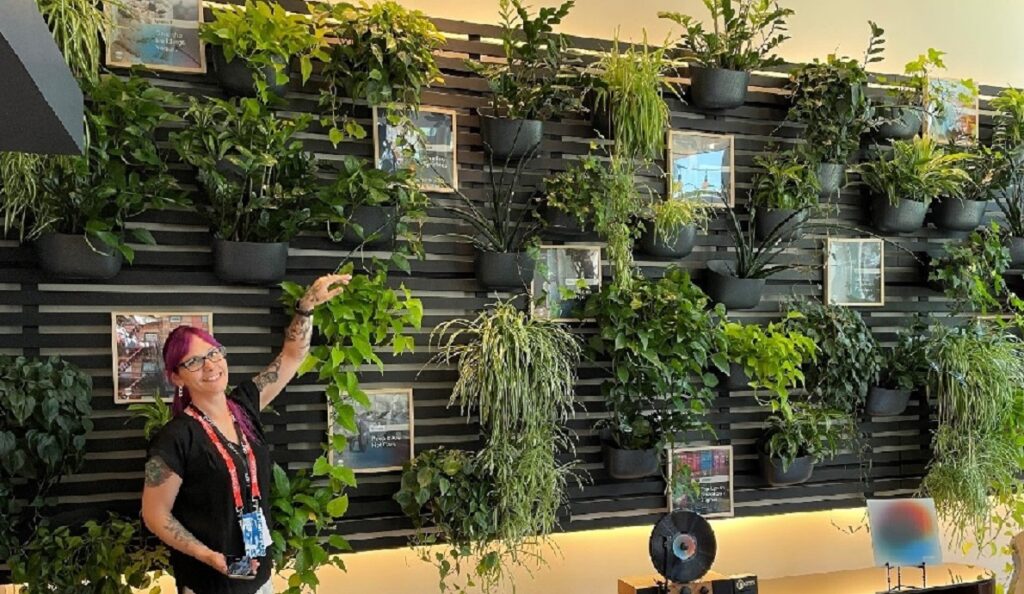
Professional Resources
Schrumpf will tell you that the best part about being an interior designer (or a student of interior design) is the access she has to great professional resources. Her favorite spot to see and learn about the latest developments and trends in design is a visit to the annual tradeshow NeoCon in Chicago. Siba students also have the opportunity of accompanying Schrumpf every June to this one-of-a-kind design-centric event, which continues to be a favorite experience of many students in the interior design program.
Students and staff in the Interior Design program also stay active in the St. Louis Chapter as well as the Siba student chapter of the American Society of Interior Designers (ASID). ASID offers opportunities for collaboration and idea-sharing between professional designers and students, opportunities for students to network with potential employers, and another source of information to learn about new trends to inspire their designs.
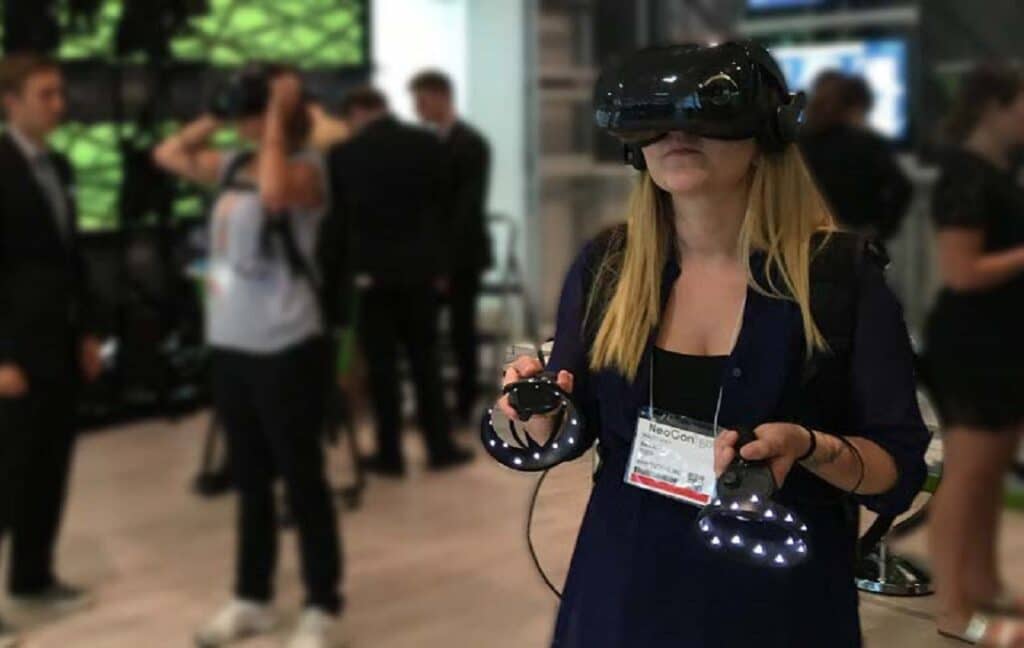
Wherever you are in your design journey, hopefully this list gave you some helpful places to find the look you’ve been searching for. And if you want that access to professional trends, perhaps the next step on your path is a degree in Interior Design. You can learn more about our program and all the resources it offers at siba.edu.
Graphic Design Skills that Make a Difference
Many think that being a successful graphic designer simply requires a solid understanding of the Adobe Creative Cloud. While this is a very important component to a career in graphic design, today’s graphic designer needs a unique blend of creativity and technical expertise to be competitive in the field. Siba’s Graphic Design Department Chair, Susan Stuart, emphasizes to her students that designers need to bring a dynamic approach to their work, from crafting visually stunning designs to communicating with clients and team members. Here are her insights and tips for building the skills needed to succeed as a graphic designer:
Mastering the Principles of Graphic Design.
Knowledge that sets formally-trained graphic designers apart is a thorough understanding of the basic principles of graphic design: contrast, balance, emphasis, hierarchy, repetition, rhythm, white space, movement, and unity. These principles guide the arrangement and structure of design elements. The way these principles are used affects the overall message and feel of a particular design. A good design is one that is functional and makes the end design useful and organized.
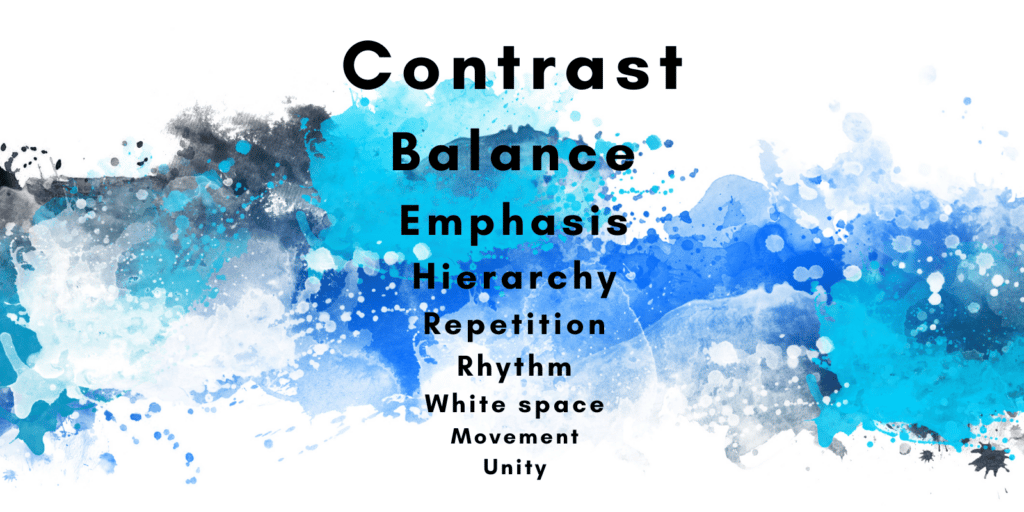
- Contrast refers to the use of different elements in a design to create visual interest and hierarchy. By using contrasting colors, shapes, and textures, designers can draw attention to specific areas of a design.
- Balance refers to the distribution of visual weight within a design. A balanced design feels stable and harmonious, while an imbalanced design feels unstable and jarring.
- Emphasis is the focal point of a design; it's the element that catches the viewer's eye first. It's used to draw attention to the most important information in a design.
- Hierarchy is the organization of elements in a design that establishes a visual order and guides the viewer's eye through the design. It's used to communicate the relative importance of different elements in a design.
- Repetition refers to the use of similar elements throughout a design. It creates a sense of unity and consistency, making a design feels cohesive and organized.
- Rhythm refers to the movement and flow of a design. It's created by repeating elements, such as shapes, colors, and patterns, in a consistent and organized way.
- White space/negative space is the area around and between the elements in a design. This essential element in graphic design helps to create a sense of balance, hierarchy, and emphasis.
- Movement refers to the way that the viewer's eye moves through a design with the use of lines, shapes, and color to guide the eye through the design.
- Unity refers to the sense of togetherness and harmony in a design. It's achieved by using the principles above in a cohesive way.
By understanding and applying these principles, graphic designers can create designs that are visually pleasing, effective, and impactful.
Communication.
According to Stuart, graphic designers need to produce, defend, and adjust their ideas for clients in both a visual and verbal way. The ability to listen carefully to the client’s needs, ask lots of questions to fine-tune and clarify ideas, and provide feedback by explaining design elements—without getting technical—will give any designer a huge advantage.
Further, good communication between the client and designer establishes trust and helps build a positive working relationship so that revisions and changes are clearly understood and the final product meets the client's expectations. It is also important for designers to be able to communicate the reasoning behind their design choices, as this helps clients to understand the thought process and strategy behind the concept.

Typography.
Stuart also explains why a strong understanding of typography is an essential skill in the graphic design field: “While fonts are downloadable everywhere, being able to use the appropriate font to communicate the client’s particular message while being visually appealing (and readable) is an important element of any design.”
The successful use of typography can have a significant impact on the overall look and feel of a design, and it can be used to convey a specific message or emotion. Good typography can help to make text easy to read and understand, and it can also be used to create a hierarchy of information, making it clear to the viewer which elements are most important. Additionally, typography can be used to create visual interest and add a unique and personal touch to a design. It can also be used to make a design stand out and to make it memorable.
Interactive Media.
Stuart advises her students to learn about as many different types of media as possible. “Design is much more than print media. It is also understanding and being able to work with interactive media or motion graphics using text, animation, video and audio messages.”
By understanding how these different mediums work and how users interact with them, designers can create more effective and user-centered designs. Interactive media can provide new opportunities for designers to showcase their skills and creativity in ways that traditional print media cannot. It is an essential skill for staying competitive and relevant in the graphic design industry.
Web Design and a “working knowledge” of coding.
While aspiring graphic designers should know the fundamentals of web design and web flow, they don’t necessarily need to be an expert at coding. Designers with a basic understanding of HTML, styles, and/ or JavaScript will have the tools they need to make it in the field.

Knowing how to code allows designers to create and manipulate website designs, build responsive and interactive layouts, and optimize websites for search engines. It also enables designers to communicate effectively with developers and other team members, so that the final product meets the client's expectations.
Siba’s graphic design curriculum aims to give students ample opportunity to learn about all of these distinct skill areas as they progress through the A.A.S. and B.A. Graphic Design programs. Well before they complete their degree, Siba students start building their portfolios and have ample opportunities to interact with professionals in the industry. These experiences help them polish their skill sets, fine-tune their individual career goals, and give them the confidence to enter the world of professional graphic design.

